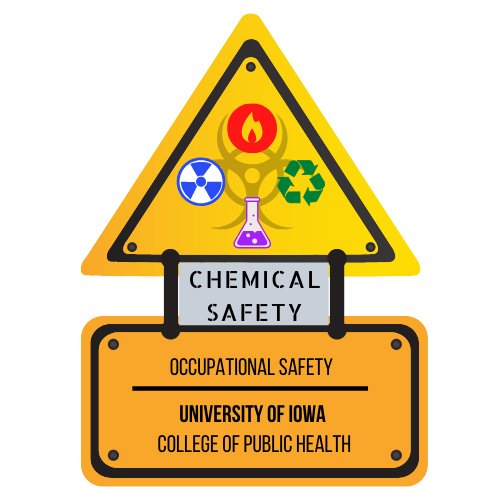Chemical Safety at Home
You may not think of your home as a source of dangerous chemicals, but there are more things to be concerned about than you may know. By being aware of hazardous chemicals in the home, you can take measures to keep yourself and your family safe by using them and storing them properly.
If you ever have any concerns that you or someone around you may have ingested a hazardous substance, call the poison control hotline at 1-800-222-1222.

Below we have answered some of the most common questions relating to chemical safety at home.
If you do not see your questions answered below, contact us at workfromhome.occsafety@gmail.com.

"Working safely with chemicals in the home is really no different than working with them in the workplace."
Chemical Safety FAQs
What are some places where I might find hazardous chemicals in the home?
You may find hazardous chemicals in your home in many different areas. Some common rooms are the bathroom, the laundry room, the garage, and the kitchen (specifically under your sink). To see a list of common chemicals encountered, click here. When working at home, it is important to put these chemicals out of the reach of children and pets.
How can I reduce my exposure to hazardous chemicals at home?
When you use cleaning products, you should ventilate your space. This is as easy as turning on a local fan or opening a window.
Never mix chemicals: Read the label which warns of dangerous reactions. The classically dangerous mix is bleach + ammonia: Hazardous chlorine gas can be released, sending you to the hospital.
Read and follow directions on chemicals you use.
Store chemicals so that: leaks are prevented, access is limited, temperatures are moderate.
When cleaning (not disinfecting), substitute cleaners with less hazardous alternatives: click here for a list of alternatives.
How can I safely store and dispose of chemicals at home?
Usage and Storage:
· Be aware of and follow the label on the bottle or package for general use.
· Never mix products unless directed on the bottle's label
· Always store chemicals in their original containers. This ensures the user knows and guarantees that the container is suited for the chemicals storage.
· Store flammable materials away from the home. Never store flammable chemicals in the open sun or near a flame or heat source
· Store chemicals out of reach of children and pets.
· Always wear gloves when using household chemicals. If splashing may be a concern, wear goggles.
When you need to throw them out:
· Always follow disposal instructions on the label. If needed, call local environmental health and services.
· Aerosol cans may contain flammable materials. If disposed of in the trash, they may catch fire.
· If a spill occurs, attempt to air out the area with fans or opening windows and doors. If the spill cannot be contained, call your local fire department.
· Never pour chemicals down the drain unless directed to do so for disposal per instructions on the bottle. The chemical may be harmful to the environment.
For more information, visit FEMA
What is the difference between cleaning and disinfecting?
Cleaning and disinfecting have different purposes. The function of cleaning is to remove dirt and messes. When we disinfect, our goal is to kill virus and bacteria. While cleaning with "safe" chemicals like lemon or vinegar might get rid of dirt, it is not sufficient of disinfecting surfaces. In times of COIVID-19, the CDC gives specific guidance here.
A quick visual reminder explaining the differences, click here.
How do I disinfect different things in my house?
Different surfaces need different techniques for disinfection. We have generated a poster to identify methods for cleaning hard surfaces, porous surfaces, laundry, electronics, and hands. For chemicals approved by the EPA as effective disinfectant chemicals for killing the novel coronavirus, visit https://www.epa.gov/pesticide-registration/list-n-disinfectants-use-against-sars-cov-2 .
What precautions do I need to take with disinfectants?
While disinfectants are important to use for helping to control infection risk, they do present inherent risks as well. During the time period from January to March 2020, poison control centers received increased calls related to cleaners and disinfectants compared to the same time period in 2019 (20.4% increase) and 2018 (16.4% increase) which may be related to increased cleaner and disinfectant use with COVID-19.
This infographic shows some important information to know when working with disinfectants to keep yourself safe and prevent injury.